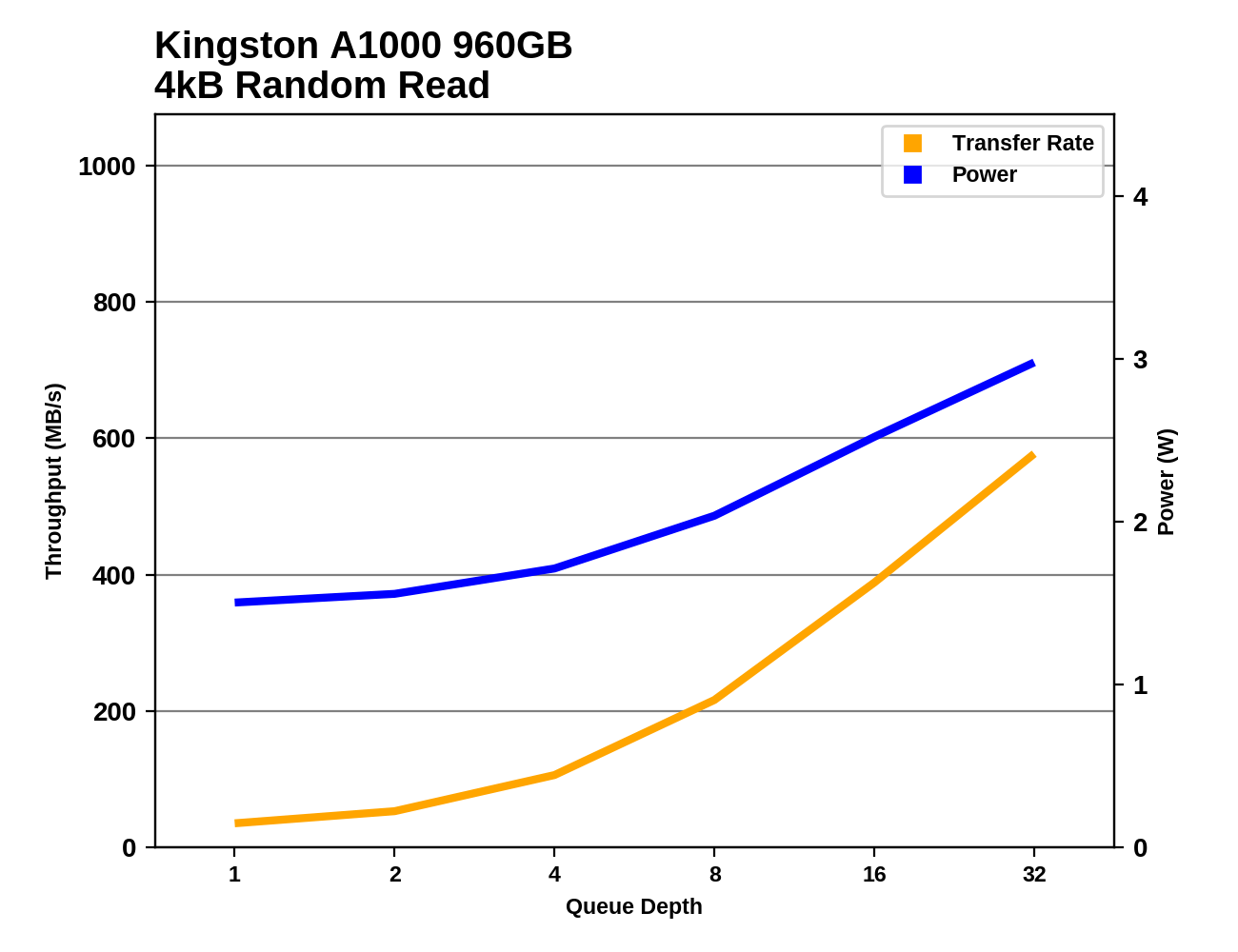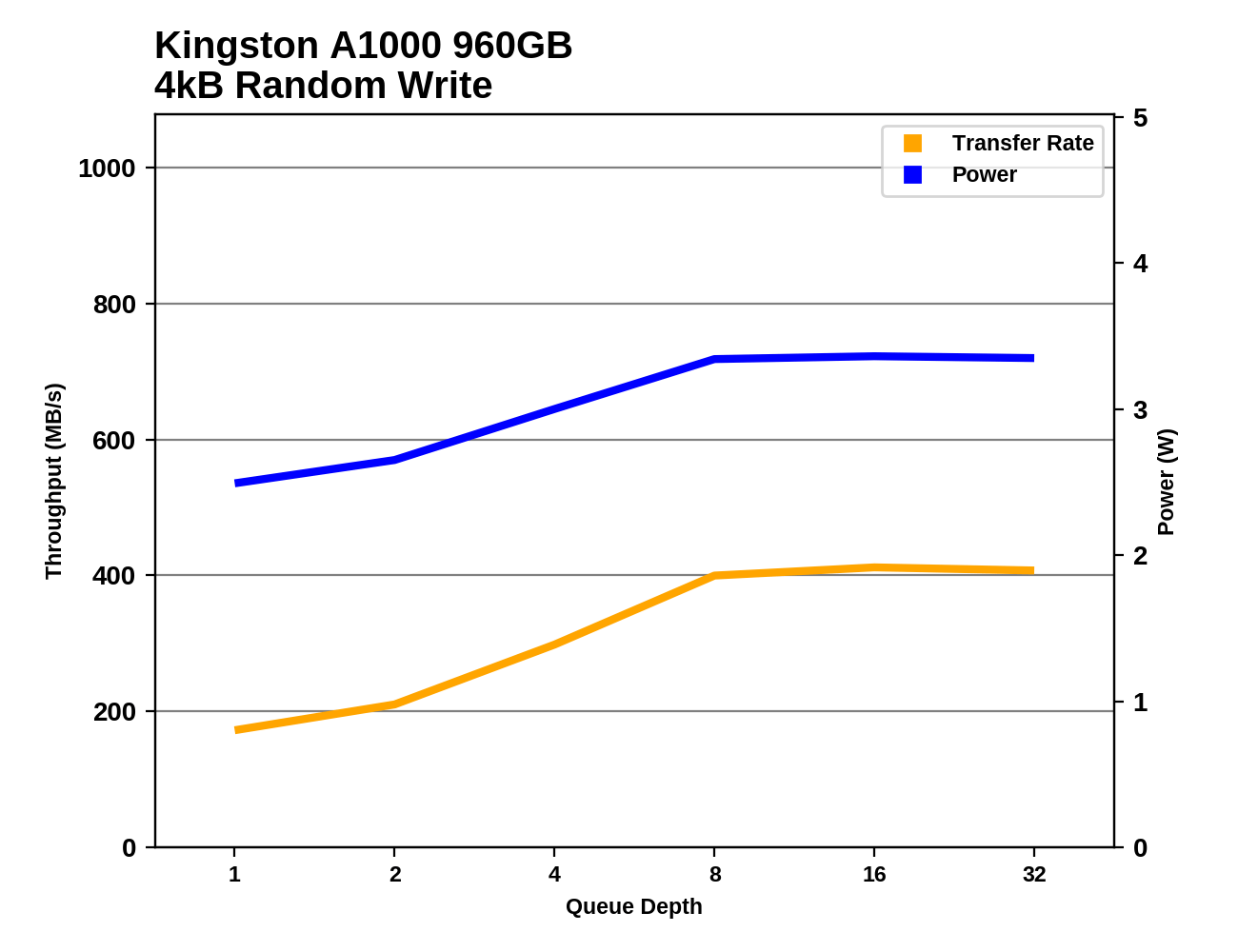The Kingston A1000 NVMe SSD Review: Phison E8 Revisited
by Billy Tallis on July 2, 2018 8:00 AM ESTRandom Read Performance
Our first test of random read performance uses very short bursts of operations issued one at a time with no queuing. The drives are given enough idle time between bursts to yield an overall duty cycle of 20%, so thermal throttling is impossible. Each burst consists of a total of 32MB of 4kB random reads, from a 16GB span of the disk. The total data read is 1GB.

The burst random read performance of the Kingston A1000 is slightly lower than that of the MyDigitalSSD SBX, and barely half that of the Toshiba RC100, both of which use the same NAND flash memory as the A1000. The older Phison E7 drives with MLC NAND are only a little bit slower than the fastest current-generation SSDs.
Our sustained random read performance is similar to the random read test from our 2015 test suite: queue depths from 1 to 32 are tested, and the average performance and power efficiency across QD1, QD2 and QD4 are reported as the primary scores. Each queue depth is tested for one minute or 32GB of data transferred, whichever is shorter. After each queue depth is tested, the drive is given up to one minute to cool off so that the higher queue depths are unlikely to be affected by accumulated heat build-up. The individual read operations are again 4kB, and cover a 64GB span of the drive.

On the longer random read test, the A1000's performance shortfall relative to the SBX is even wider, and the A1000 is one of the slowest current-generation NVMe drives on this test. The Toshiba RC100's performance is in last place, because the sustained random read test covers a larger portion of the drive than the RC100's host memory buffer is set up to cache metadata for.
 |
|||||||||
| Power Efficiency in MB/s/W | Average Power in W | ||||||||
The power consumption of the Kingston A1000 during random reads is only slightly higher than the SBX, but since performance is also worse that adds up to a clear efficiency gap. The SBX is in the top tier of flash-based NVMe SSDs for efficiency on this test, and the A1000 is in the second tier. The older Phison E7-based Patriot Hellfire performed reasonably, but was quite power hungry in comparison to today's drives.
 |
|||||||||
The random read performance of the Kingston A1000 shows very good scaling as queue depth increases, though it never manages to catch up to recent high-end NVMe SSDs. However, the sub-par performance at low queue depths is far more important to everyday usage.
Random Write Performance
Our test of random write burst performance is structured similarly to the random read burst test, but each burst is only 4MB and the total test length is 128MB. The 4kB random write operations are distributed over a 16GB span of the drive, and the operations are issued one at a time with no queuing.

The burst random write performance of the Kingston A1000 is slightly better than the MyDigitalSSD SBX, but both are still behind almost all current NVMe SSDs. The Phison E7 drives with MLC NAND are a bit faster than the A1000 and SBX, so the newer drives are a step backwards in spite of the addition of SLC write caching.
As with the sustained random read test, our sustained 4kB random write test runs for up to one minute or 32GB per queue depth, covering a 64GB span of the drive and giving the drive up to 1 minute of idle time between queue depths to allow for write caches to be flushed and for the drive to cool down.

Aside from the Toshiba RC100 falling to last place, nothing looks better for the Kingston A1000 on the longer random write test. The sustained random write performance of the A1000 or the SBX is less than half that of a high-end NVMe SSD.
 |
|||||||||
| Power Efficiency in MB/s/W | Average Power in W | ||||||||
The 960GB A1000 requires significantly more power during the sustained random write test than the 480GB model, but it offers essentially the same performance, so the larger A1000 has a lower efficiency score. All of the Phison E8 drives fare poorly on this metric compared to high-end NVMe SSDs and good SATA SSDs, but it's not quite the factor of two spread that the raw performance shows.
 |
|||||||||
The Kingston A1000 shows similar queue depth scaling behavior to the MyDigitalSSD SBX, with performance topping out at QD8—rather late in the test compared to how most drives behave. Most other NVMe SSDs scale up to higher performance and get there with lower queue depths.










26 Comments
View All Comments
leexgx - Wednesday, July 4, 2018 - link
I am fine with no smaller ssds as anything below 240gb is not really enough and cost only 20 more then a 120gb model any wayzepi - Monday, January 7, 2019 - link
Let's return to the old review of the "crappy" product after half a year has elapsed.A relative gets a quite nice (for his budget) 6-core intel laptop from Black Friday sales, but it only comes with an HDD.
I want to get him an SSD that fits the M.2 slot that the machine has. Laptop datasheet leads me to believe that this very specific model number doesn't support SATA over M.2 (many other sub-models list both Sata M.2 and pcie NVMe, but this one particularly mentions only NVMe pcie)
My limited gift budget allows me to choose 480GB Kingston or 256GB EVO970 from Amazon as I don't have time or possibility to shop around in local stores.
So for about 90 euros I can choose either faster 256GB or slower 480GB m.2 drive. Choice is clear. In this case bigger is better, even though it is a bit slower. Under most practical day to day use the Kingston is a much better choice as it is quite easy to fill a 250GB SSD, but difficult to max out the iops of A1000 in a way that bothers the user badly.
EV970 500GB would require about 50% increase in gift budget. Not impossible, but I see very little value from the extra speed, while even the entry level pci-e M.2 SSD is an insane leap for the laptop.
Corsair P1 500 would also have been an option, but at that particular moment it was more pricey.
So yeah, even the "worst" of their class SSD's have value to offer.
I see very little value in faster nvme drives for most people. We've come a long way from the times of Intel X25-M. Even the crappy SSD's are quite good these days.